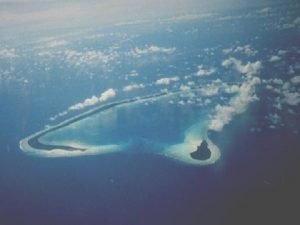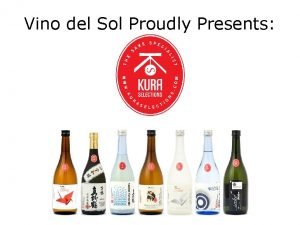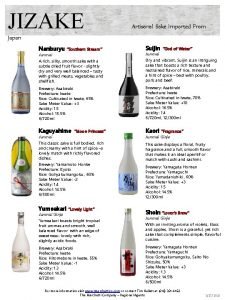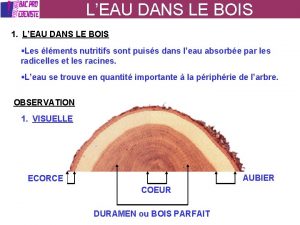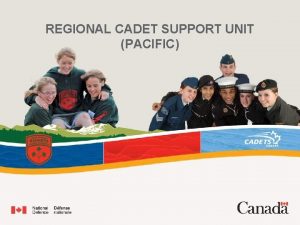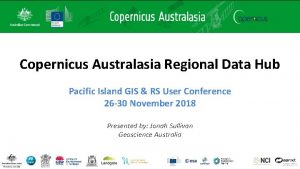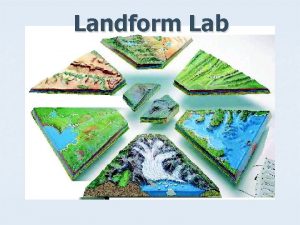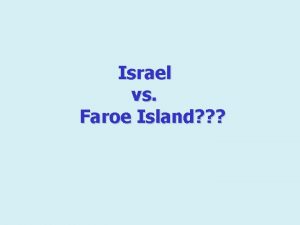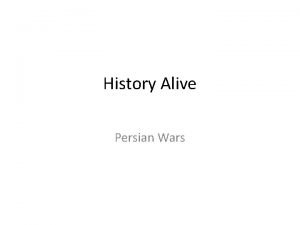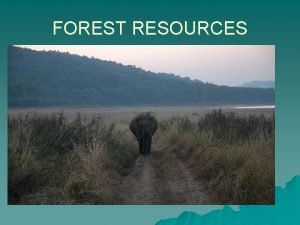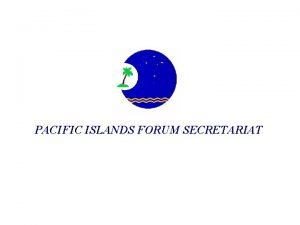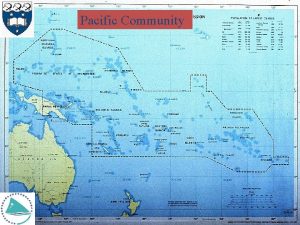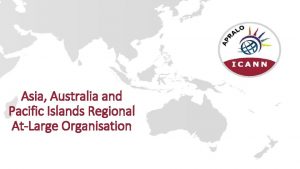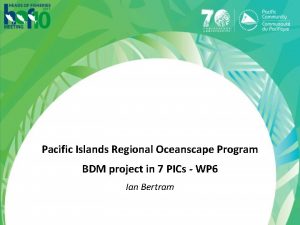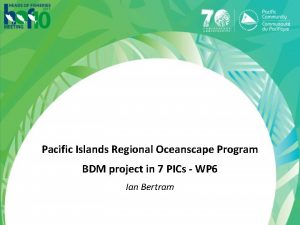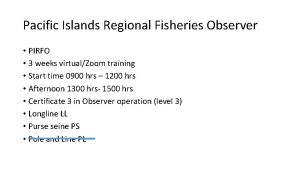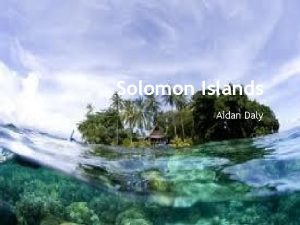Regional artisanal data collection FAOSPC Pacific Islands Regional















- Slides: 15

Regional artisanal data collection FAO/SPC Pacific Islands Regional Consultation on the Development of Guidelines for Securing Sustainable Small-Scale Fisheries 12 -14 June 2012

Why collect artisanal data? Artisanal fisheries make a significant contribution to GDP in Pacific Island Countries and Territories 2009 contribution by artisanal fisheries to GDP Freshwater 3% Aquaculture 10% Artisanal 19% Foreign license revenue 12% Offshore (domestic PS; LL; P&L) 31% Subsistence 26% Source: Gillett, R. (2009), Fisheries in the economies of the Pacific island countries and territories. ADB.

Why collect artisanal data? • To quantify the contribution of artisanal fisheries to: – Livelihoods – Food security – Employment – GDP and terms of trade – Culture – Recreation and tourism • To quantify the value of FADs • For domestic and regional (WCPO) management purposes

Need to know for better management Scientific: • Annual catch and effort of tuna and other pelagic fish? • Interactions between commercial and artisanal fisheries? • Effect of FADs on catch rates and size of pelagic fish? Economic: • Value of the contribution of the artisanal fishery to GDP? • Are artisanal fishers profitable? • What is optimum level of effort to maximise the economic benefits from the artisanal fishery? • Do FADs give a positive financial return? Socioeconomic: • What is the contribution of the artisanal fishery in terms of: – Food security; and – Employment and livelihoods. • How effective are FADs in achieving their socioeconomic objectives? • How many people benefit directly and indirectly from the artisanal fishery?

What is the artisanal tuna data collection programme? The main objective is to make total catch estimates for small-scale (or artisanal & subsistence) fishing vessels that target tuna and other pelagic species. Secondary objectives are to monitor length frequencies and economic data for fisheries management. Method Catch and effort data is collected at the trip level by a combination of: 1. Logbook forms that collect catch and effort data at the trip level; 2. Fishing activity collects effort information (number of trips), which is used to estimate logbook coverage and total catch and effort; 3. Length frequency sampling at a level of 5% (minimum) of total trips to provide fishery management data. ; and 4. Economic sampling collects fishing vessel cost data at the trip level

The Forms

The Forms

The Forms

The Forms

Issues with the Forms 1. Fishing Event The logbook form is set up to capture one ‘Fishing Event’. A fishing event is a period of time in which a vessel uses one type of fishing gear in one fishing area. A new form should be started when a new or an additional fishing event is started. This is important consideration in the artisanal fishery as vessels often switch gears during the trip. If you already have national logbook form for artisanal fisheries, check whether it can capture ‘fishing events’.

Form issues contd. 2. Fishing Activity Form Is a key form as it indicates the total number of trips that have been carried out. Logbooks only indicate the catch for one trip. It helps to gauge the logsheet coverage. It can be difficult to implement this form, especially if you are aiming to capture 100% of trips. Your ability to do this will depend on local conditions, no. of boats / no. of fishery officers / budget / etc. 3. The final use of the fish The logsheet form does not capture the final use of fish (sale, consumption, price, etc) as this is not known at the point of unloading. Market survey data is needed to capture this information. (New Market Survey Manual being developed by CFP, SPC)

Form issues contd. 4. Vessel economic data Does not collect fixed costs (or overheads) that are incurred by SSF. The objective is to collect cost data at the trip level to identify trends over time and the impact that FADs have on cost per unit of effort at the trip level. Excluding fixed costs does impact our ability to use economics as a fishery management tool (MEY).

NEW ! Links with other data collection programmes The same forms can be used to collect data from other vessel based fisheries. Using the same form across different fisheries will make things easier for staff, data management , etc. Ø Deep Bottom Snapper Fishery Ø Sports Fishing Vessels Ø Creel and Market Survey

TUF-ART DATBASE • Based on the Industrial Fisheries Database – TUFMAN • MS Access standalone database – not connected to TUFMAN, so can be installed in an independent office (i. e. Coastal Fisheries) • Data entry and basic reporting in place, further developments to take place

Resources Aus. AID funding (2012 to 2015) Generous amounts for positions and equipment. National data workshops (best for countries with multiple staff) Regional Artisanal Data Workshop (2013) Manual for artisanal tuna data fishery (first draft available)
 Pacific islands
Pacific islands Countless visions sake
Countless visions sake Artisanal sake
Artisanal sake Séchoir à bois artisanal
Séchoir à bois artisanal Rcsu pacific
Rcsu pacific Landsat collection 1 vs collection 2
Landsat collection 1 vs collection 2 Documents against payment
Documents against payment Procedures of data collection
Procedures of data collection Data collection secondary data sources
Data collection secondary data sources Pacific data hub
Pacific data hub Are oxbow lakes constructive or destructive
Are oxbow lakes constructive or destructive Japan northern hemisphere
Japan northern hemisphere Israel vs faroe island
Israel vs faroe island Why did the athenians sail to nearby islands in panic?
Why did the athenians sail to nearby islands in panic? Deforestation
Deforestation Spanish speaking islands in the caribbean
Spanish speaking islands in the caribbean
